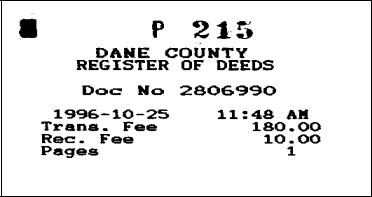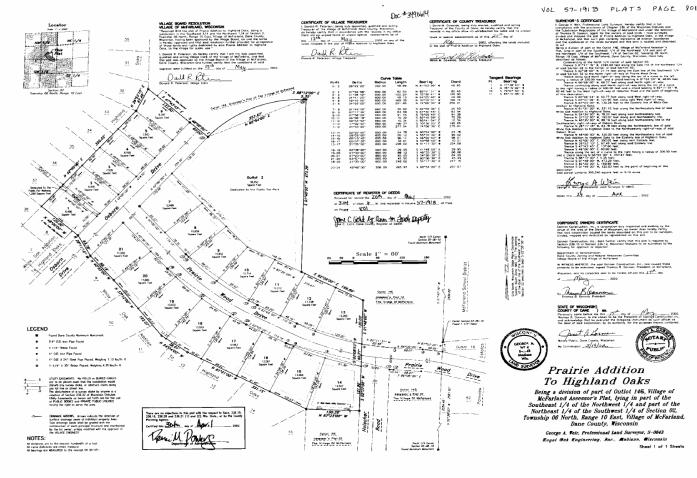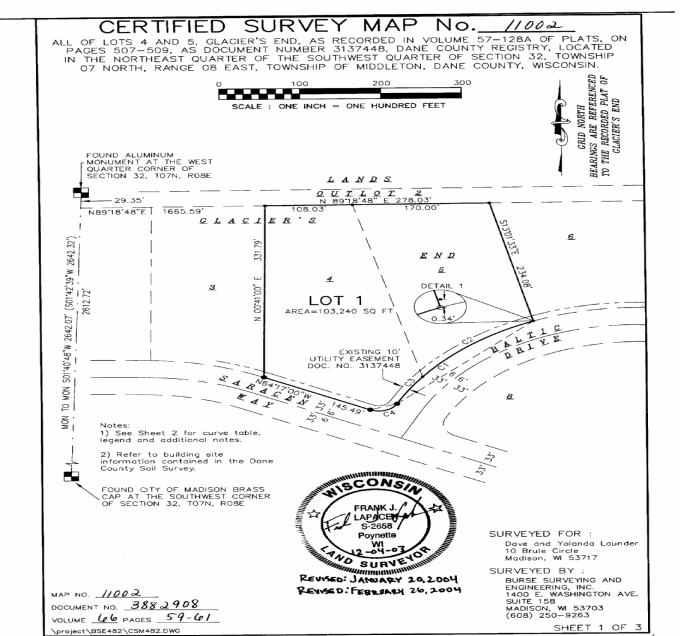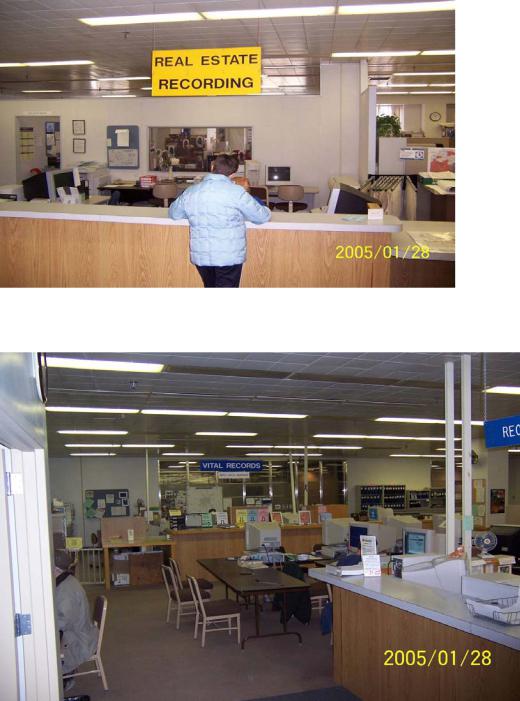
Экзамен зачет учебный год 2023 / Steinfield, Land Registration and Land Fraud in the United States
.pdfLand Registration and Land Fraud in the United States
By
J. David Stanfield, Jeff Underwood, Kirthimala Gunaskera of Terra Institute and
Carl Ernst, Property Records Industry Association
21 October, 2008
Paper presented to the Seminar on Risk Reduction in Land Fraud 22-23 October, 2008
Grand Blue Wave Hotel
Shah Alam
Selangor Darul Ehsan
Malaysia
1
|
|
TABLE OF CONTENTS |
|
1. |
Land Registration in the United States: Recording of Real Property Related Documents |
...3 |
|
2. |
Land Fraud: Recent US Experience..................................................................................... |
3 |
|
3. |
Features of the Register of Deeds, Dane County, Wisconsin............................................... |
6 |
|
|
3.1 Registrar Duties ............................................................................................................... |
9 |
|
|
3.2 Transparency and Accessibility ..................................................................................... |
11 |
|
|
3.3 Accepting and Rejecting Documents for Recording ..................................................... |
12 |
|
|
3.4.1 Statutory Requirements Governing Acceptance of Documents ............................. |
12 |
|
|
3.4.2 Rejecting Documents for Recording....................................................................... |
13 |
|
4. |
The Register of Deeds and Land Fraud ............................................................................... |
14 |
|
|
|
LIST OF FIGURES |
|
Figure 1 |
Time and date stamp .............................................................................................. |
7 |
|
Figure 2 |
Plat map ................................................................................................................ |
8 |
|
Figure 3 |
Certified survey map (CSM)................................................................................ |
9 |
|
Figure 4 |
Real Estate recording section.............................................................................. |
10 |
|
Figure 5 |
Vital records area of Dane County Register of Deeds........................................ |
10 |
|
Figure 6 |
Public access areas for computer search of records. .......................................... |
11 |
|
Figure 7 |
Authentication or acknowledgement area of a typical deed. .............................. |
12 |
|
Figure 8 |
One form of a legal description on a typical deed .............................................. |
13 |
|
2
Land Registration and Land Fraud in the United States
1. Land Registration in the United States: Recording of Real Property Related Documents
In the United States there are 3,141 counties or county-equivalent administrative units contained in the 50 states, governed by publicly elected officials and career civil servants. The responsibilities of county governments vary widely from state to state, as does the relationship between counties and incorporated municipal governments.
One responsibility of most counties and some of the larger municipal governments is the operation of a Register of Deeds. Although the title of the head official varies, this local government office in essence operates a constantly updated archive of documents which describe rights to real property, indexed by names of the participants in these transactions, the geographical locations of the properties affected and other characteristics of transactions. The intake of these documents is called “recording”, and not “registration”, although the official in charge of the office is often called a Registrar and the office itself may be called a Register. See Annex 1 for the complete text of Chapter 59.43 of the Wisconsin Statutes pertaining to obligations and procedures of a Register of Deeds in that state.
A deed is defined as a written instrument that, when executed and delivered, conveys title or an interest in real property from a seller or “grantor” to a buyer or “grantee”. It is a written record of a single transaction between two parties and provides evidence that the transaction has taken place. However, a deed is not in itself proof of the legality of the transfer of title or interest in the real estate. Before any sale transaction is completed, the person intending to acquire an interest in land is responsible to trace the seller’s legal right to sell back in time through preceding transactions documented by archived deeds to a ‘good root of title’ as evidenced by properly documented transactions. The search must also identify any other transaction recorded in the Register of Deeds, such as mortgages, liens, powers of attorney, and other documented potential interests in a property, which affect the conveyance of clear title or interest in the property. This search must be repeated each time that a transaction occurs which affects rights to a particular property, to assure the person who wishes to acquire a right to a property that the seller of that right can effect the transaction and that there is no “cloud” on the title being conveyed. In particular, this search should help identify any fraud contained in previous transactions, although as we shall see this fraud detection function of searches needs strengthening.
In the US system the chain of title review is usually performed by a professional title abstractor or attorney, and the clear title is guaranteed either by a title insurance company or by an attorney, subject to some exclusions which may be quite significant.
2. Land Fraud: Recent US Experience
Transactions involving rights in land can be twisted in various ways to violate the legal and legitimate rights of land owners, buyers, sellers, lenders, renters, heirs, and governmental agencies. We define land fraud as a material misstatement, misrepresentation or omission which people rely upon to effect illegally a transaction involving real estate to their benefit or to the detriment of others. Perpetrators of land fraud:
3

accomplish illegal sales through counterfeit ownership documents;
acquire under-secured loans through falsified value assessments;
perform outright theft perpetuated on legal owners and lending institutions through counterfeit mortgage satisfactions, and many other schemes.
We present this discussion paper in order to help develop plans of action to reduce the incidents of land fraud where they have become a problem, in counties, in states and in countries around the world.
Key elements of a typical land fraud scheme are conspiracy, overvaluation of property and naïve (straw) buyers1.
The steps in an example of an “equity skimming” land fraud crime in the U.S. are:
1.Leader (typically a mortgage broker, who is also a speculator) buys property in a business name for $425,000.
2.Co-conspirator finds out-of-town, naïve “straw buyer”.
3.Straw buyer contracts to buy property for $741,000, less than one month after it was purchased.
4.Co-conspirators (the “professionals”) facilitate financing: mortgage broker generates fraudulent mortgage application; appraiser overstates property value; title/closing agent conceals prior related transaction(s), falsifies housing loan forms, and disburses borrowed funds to mortgage broker; notary public, who is also closing agent, takes acknowledgements of loan documents from straw buyer.
5.Co-conspirators make $266,000 profit.
6.Repeat: scheme executed on more than 20 properties before law enforcement caught up with the perpetrators.
Victims of this scheme include lenders, straw buyers (destroyed credit and subject to legal prosecution), neighboring home owners (reduced property values), title insurance companies (possibly), city and county (reduced property tax collections) and the reputation of the land ownership system.
Step 4 in this scheme is called “mortgage fraud,” which is defined by the FBI as “A material misstatement, misrepresentation or omission relied upon by an underwriter or lender to fund, purchase, or insure a loan.” Note however that the mortgage fraud is not the crime, but only a step in the overall scheme that monetizes the crime. It is the gun used in the robbery.
With the self-destruction of housing markets, this particular scheme which depends to some extent on rising housing prices is no longer popular, but the basic methodology is used in other mortgage rescue fraud schemes. A version of the scheme, involving a “short sale” of a foreclosed property, is popular in a down market, like the present conditions in the US.
Four common schemes in the US include:
•Appraisal Fraud: A property is overor undervalued, often due to pressure from loan originators and real estate agents to alter appraisal reports. This pressure can be
1 A person who purchases property for another to conceal the identity of the real purchaser.
4
negative (yelling or threatening) or seemingly positive (gifts and other illegal kickbacks).
•Flipping: A home is purchased and "flipped" or sold immediately for a severely inflated price, often upwards of 30 to 50 percent of the original selling price. That initial transaction is often concealed from the lender. The loan is never repaid and the lender is left high and dry.
•Identity Theft: This type of fraud can range from stealing a customer's identity, to using false names to take out loans, to an appraiser’s using another's name to make false valuations. Identity theft happens swiftly, and finding someone whose real identity is not stated in the transaction documents after the loan is completed can be nearly impossible. US financial institutions' reports of identity theft in conjunction with mortgage fraud have increased in 2007 approximately 96 percent since a previous 2006 study.
•Straw Buyers: One person (or company) pays someone else to pose as the home buyer, using their own information and credit score (real or false) to purchase a property. The straw buyer thinks she will not have to make any mortgage payments. The scammers then take over the title and mortgage. Essentially, the lenders think they're loaning money to one person, when in actuality, the home will be owned by someone else, and eventually will be foreclosed.
Mortgage fraud is a large and growing blight on the mortgage industry in the US. The Federal Bureau of Investigation (FBI) has reported that mortgage fraud cost the mortgage lending industry between $946 million and $4.2 billion in 2006 alone. Additionally, the federal Financial Crimes Enforcement Network (FinCEN) has reported that more than 37,000 mortgage-related Suspicious Activity Reports (SARs) were filed in of 2006, an increase of 44 percent over the same period in 2005. The number of SARs increased to nearly 53,000 in 2007, an increase of over 100% in the two years since 2005.
The extent of land fraud in general that is surfacing in the US alone is, frankly, overwhelming. There is not enough time to read all the articles that are being written these days. An estimate is that the population of land fraud criminals in the U.S. tops 50,000 nationwide, many of whom started their education in land fraud in the 1990’s or early 2000’s, and their careers in the early 2000’s, but many of them are not being detected and prosecuted because of:
1.Lack of adequate fraud detection processes.
2.Lack of industry/government cooperation at local and state levels.
3.Lack of local law enforcement interest due to lack of education and funding.
4.The supposed complexity of land fraud cases.
5.Lack of federal law enforcement resources. Only 1,000 cases or so are prosecuted by national law enforcement (i.e., the FBI). This number is just the tip of the iceberg.
6.Lack of consumer education.
7.Failure to utilize available technology.
8.Inadequacies in existing legislation.
Mortgage fraud has also become easier under the new financial regime whereby the initial lenders use mortgages to provide security for the monies they lend, but then turn around and sell those mortgage agreements to “investors”. The initial lenders thereby pass on to the “investors” the risks of the mortgages going bad, and are insulated from loses when
5

borrowers do not repay. In essence many of the initial lenders who have the local contacts and information to do careful mortgage lending have not investigated their clients as they once did, in the interest of selling mortgages and earning big bonuses as quickly as possible. Buyers of those mortgages package them into “securities” involving many, perhaps thousands, of mortgages of varying terms, quality and care of preparation and sell them to yet other “investors”. Such behavior itself has at least the appearance of fraud, that is, misrepresenting a package of mortgages as all equal and of known risk, when in fact they are a mish-mash of mortgage agreements. But what appears to be fraud is not considered as such, at least not yet, by the US public prosecutors, perhaps due to practice being so prevalent in recent years, that should it be prosecuted as fraud, most mortgage based investment financiers would be in jail and their ill gotten assets confiscated for repayment of losses suffered by the borrowers and naïve investors, which seems to be exceeding several trillion US dollars.
But even with a more restricted definition of land fraud, the costs for the victims are significant. They often lose most if not all of what they invested in transactions contaminated by fraud.
Moreover, as fraudulent transactions become more numerous and as fraudulent documents accumulate in registries of deeds, the costs of investigating each recorded document for its validity become exorbitant. The risks of engaging in land market transactions due to fraudulent documents in register archives constrain the operations of those markets. People and institutions which desire to engage in land transactions lose confidence in the deeds/title registries whose purpose is precisely to provide evidence of title to land. The past investments in these registries and regularization of title are threatened. People turn against the official registries and either refrain from transactions or conduct them informally, further undermining the capacities of the registries to support the security and dynamism of the market economy.
Government and private sector entities engaged in serving and guiding the operations of land markets agree that land fraud crime should be prosecuted. However, statistics indicate that the time between the initiation of a specific land fraud crime and the investigation, indictment and conviction of the criminals involved may be five years or more. Although tougher laws will ultimately take the criminals off the streets and will deter others from committing land fraud crime, the focus must be on deterrence rather than just prosecution of crimes. The participation of law enforcement and land related administrative officials from the local, state and federal level is vital because effective crime-fighting also requires cooperation between government and private sector entities and law enforcement at all levels.
The remainder of this paper has two objectives: 1) present the purposes and operational features of a typical Register of Deeds—that of Dane County, Wisconsin; and 2) describe how registrars and related professionals are reacting to reduce the risks of land fraud.
3. Features of the Register of Deeds, Dane County, Wisconsin2
The office of the Register of Deeds files, records and issues instruments and documents of significance to both the community as a whole and to its individual citizens. Several types of
2 See Jane Licht and J. David Stanfield (2005), “Modernizing the Register of Deeds in Dane County, Wisconsin”, Terra Institute Research Paper, Mt. Horeb, Wisconsin for more information on the operations of the RoD in Dane County.
6

documents are recorded at Dane County’s Register of Deeds:1) vital records which document the span of Dane County people’s lives--birth, marriage, and death; 2) real estate related records documenting title and other interests in Dane County’s real property, worth over $3.6 billion in 2004; 3) subdivision plats and certified survey plans; 4) organizational documents of corporations, fraternal societies, religious organizations, associations; 5) military discharges.
The recording of various legal documents concerning real estate with the Register of Deeds is a way of putting the world on notice that something important has happened or will happen concerning a parcel of land or a building. The most important element in this recording process is the official notation on the recorded document of the time of the acceptance of the document for recording. (see Fig. 1)
In fact, the public record is established at the exact time when the Register of Deeds places its stamp on the document presented to it. In legal terms, this important function provides constructive notice for the entire world to see the rights and interests that people have in real property, as well as notice regarding births, deaths, and marriages which have occurred within the county.
Figure 1 |
Time and date stamp |
Providing constructive notice regarding real estate, allows the act of searching the records and the determination of clear title. This is necessary for the issuance of most home mortgages, business loans, and the sale of real estate. The entire massive database of recorded documents and other documents such as plat maps (see Fig. 2) and certified survey maps
7

(see Fig. 3) are stored and made available for public view. These documents provide accurate descriptions of property and helps individuals avoid wasteful court battles over boundaries and rights. Local government property tax rolls are derived from the documents recorded in the office of the Register of Deeds.
Figure 2 |
Plat map |
8

Figure 3 |
Certified survey map (CSM). |
3.1 Registrar Duties
The purpose of the Register of Deeds Office in Dane County is to provide official record keeping for all real estate, personal property and vital statistics for the County and to provide a convenient and public place where documents can be filed and examined per Wisconsin Statutes.
The Registrar is responsible for reading the law and judging whether the law requires the recording of documents presented.
9

Cooperation with various professional groups and individuals is viewed as an important aspect of this mission as is the continuation of automation, statutory changes and performance evaluations.
The Register of Deeds Office receives, records and archives real estate documents (see Figure 4) using a variety of paper and electronic documentation. Vital Records (see Figure 5) are received through various sources, indexed, duplicated and filed in the office. For example, marriage certificates are sent to the Register of Deeds by the persons empowered by the state to conduct marriage ceremonies.
Figure 4 |
Real estate recording section |
Figure 5 |
Vital records area of Dane County Register of Deeds |
10
